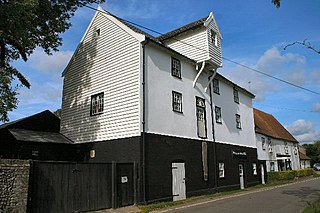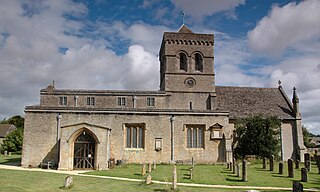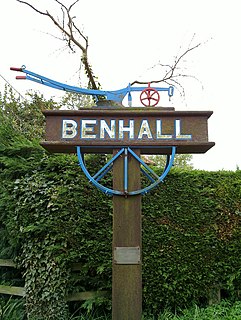
Shackleford is a village and civil parish in the Borough of Guildford, Surrey, England centred to the west of the A3 between Guildford and Petersfield 32 miles (51 km) southwest of London and 5.2 miles (8.4 km) southwest of Guildford. Shackleford includes the localities of Eashing, Hurtmore, Norney and Gatwick.

Woldingham is a village and civil parish high on the North Downs between Oxted and Warlingham in Surrey, England, within the M25, 17.5 miles (28.2 km) southeast of London. The village has 2,141 inhabitants, many of whom commute to London, making Woldingham part of the London commuter belt. The village is served by the Oxted line and central London can be reached in 33 minutes by train.

Leiston Abbey outside the town of Leiston, Suffolk, England, was a religious house of Canons Regular following the Premonstratensian rule, dedicated to St Mary. Founded in c. 1183 by Ranulf de Glanville, Chief Justiciar to King Henry II (1180-1189), it was originally built on a marshland isle near the sea, and was called "St Mary de Insula". Around 1363 the abbey suffered so much from flooding that a new site was chosen and it was rebuilt further inland for its patron, Robert de Ufford, 1st Earl of Suffolk (1298-1369). However, there was a great fire in c. 1379 and further rebuilding was necessary.

Aldringham is a village in the Blything Hundred of Suffolk, England. The village is located 1 mile south of Leiston and 3 miles northwest of Aldeburgh close to the North Sea coast. The parish includes the coastal village of Thorpeness. The mid-2005 population estimate for Aldringham cum Thorpe parish was 730.

Sternfield is a village in Suffolk, England. It is located 1 mile (2 km) south of Saxmundham, its post town. The village is very small and irregularly built, and is wholly agricultural.

Tatsfield is a village and civil parish in the Tandridge District of Surrey, England. It is located 3.3 miles north west of Westerham and 3.9 miles north east of Oxted, and is adjacent to the Surrey border with both Greater London and Kent.

Pakenham is a village and civil parish in the West Suffolk district of Suffolk in eastern England. Its name can be linked to Anglo-Saxon roots, Pacca being the founder of a settlement on the hill surrounding Pakenham church. The village describes itself as the "Village of Two Mills", as it has a water mill which claims to be the only working example in the county. The Pakenham windmill no longer works.

Nuneham Courtenay is a village and civil parish about 5 miles (8 km) southeast of Oxford. It occupies a pronounced section of the left bank of the River Thames.

Kirtlington is a village and civil parish in Oxfordshire about 6+1⁄2 miles (10.5 km) west of Bicester. The parish includes the hamlet of Northbrook. The 2011 Census recorded the parish's population as 988. The parish measures nearly 3 miles (5 km) north–south and about 2+1⁄2 miles (4 km) east–west. It is bounded by the River Cherwell to the west, and elsewhere mostly by field boundaries. In 1959 its area was 3,582 acres (1,450 ha).

Burstow is a village and civil parish in the Tandridge district of Surrey, England. Its largest settlement is Smallfield. Smallfield is 2.5 miles (4.0 km) ENE of Gatwick Airport and the M23 motorway, 7.5 miles (12.1 km) southwest of Oxted and 1.8 miles (2.9 km) east of Horley. Crawley is a nearby large commercial town, 3.7 miles (6.0 km) southwest of Burstow and 5 miles (8.0 km) southwest of Smallfield. Towards the outside of the London commuter belt, some residents commute to the capital by road or rail from here as London is 24.5 miles (39.4 km) to the north or Horley railway station is accessible.

Freckenham is a small rural village and civil parish in the West Suffolk district of Suffolk in East Anglia, in the country of England.

Benhall Green is a village in Suffolk, England. Benhall Green has a ford over the Fromus - which can be treacherous during heavy rains - and several protected wildlife sites, including the Wadd. The village also has a St Mary's Benhall Primary school, rated excellent by Ofsted, a new wooden play area, swings and slides, a phone box, and a noticeboard. There is a small farm shop on the A12 just outside the village, the Railway Farm Shop. In the village is a cottage built in 1698 with distinctive pargeting.

Sudbourne is a village and civil parish in Suffolk, England, located approximately 2 miles (3 km) north of Orford.

Chevington is a village and civil parish in the West Suffolk district of Suffolk in East Anglia, England. Located around 10 km south-west of Bury St Edmunds, in 2005 its population was 630, reducing to 602 at the 2011 Census. The parish also contains the hamlets of Broad Green and Tan Office Green.

Hanwell is a village and civil parish in Oxfordshire, about 2 miles (3 km) northwest of Banbury. Its area is 1,240 acres (500 ha) and its highest point is about 500 feet (150 m) above sea level. The 2011 Census recorded the parish's population as 263.

Butley Priory, sometimes called Butley Abbey, was a religious house of Canons regular in Butley, Suffolk, dedicated to The Blessed Virgin Mary. It was founded in 1171 by Ranulf de Glanville, Chief Justiciar to King Henry II (1180-1189), and was the sister foundation to Ranulf's house of White canons (Premonstratensians) at Leiston Abbey, a few miles to the north, founded c. 1183. Butley Priory was suppressed in 1538.
Sir Edward Duke, 1st Baronet was an English politician who sat in the House of Commons of England in 1640.

The A1094 is an A road in the English county of Suffolk. It is around 7 miles (11 km) in length. The road runs from a junction off the A12 trunk road at Friday Street in Benhall to Aldeburgh on the North Sea coast. The road is single carriageway throughout.
Sir Edward Duke, 3rd Baronet, of Benhall, Suffolk, was a British politician who sat in the House of Commons from 1721 to 1722

Buckenham Tofts is a now deserted historic parish and manor in Norfolk, England, situated about 7 miles north of Thetford, and since 1942 situated within the Stanford Training Area, a 30,000-acre military training ground closed to the public. It was situated about one mile south of the small village of Langford, with its Church of St Andrew, and about one mile west of Stanford, with its All Saints' Church and one mile north of West Tofts, with its Church of St Mary, all deserted and demolished villages. None of these settlements are shown on modern maps but are simply replaced by "Danger Area" in red capital letters. It is situated within Breckland heath, a large area of dry sandy soil unsuited to agriculture. The parish church of Buckenham Tofts, dedicated to St Andrew, was demolished centuries ago and stood to the immediate north of Buckenham Tofts Hall, the now-demolished manor house, as is evidenced by a graveyard which was discovered in that location. The parishioners, few as they were, used nearby St Mary's Church, West Tofts, one mile to the south, where survive 18th-century monuments to the Partridge family of Buckenham Tofts. In 1738 the Norfolk historian Blomefield stated of Buckenham Tofts "there is nothing remaining of this old village, but the Hall, and the miller's house". The ancient manor house was rebuilt in 1803 by the Petre family in the Georgian style and on a grand scale, was sold with the large estate in 1904 and was finally demolished by the army in 1946, having suffered major damage from military training exercises and shelling. In the early 21st century the remains of the manor house were described as follows: "a grassy platform of raised ground and beside a short line of dilapidated stone steps. The raised ground made a sort of elevated lawn, large enough for a tennis court or two, and the steps went to the top of the platform, and then went nowhere."




















